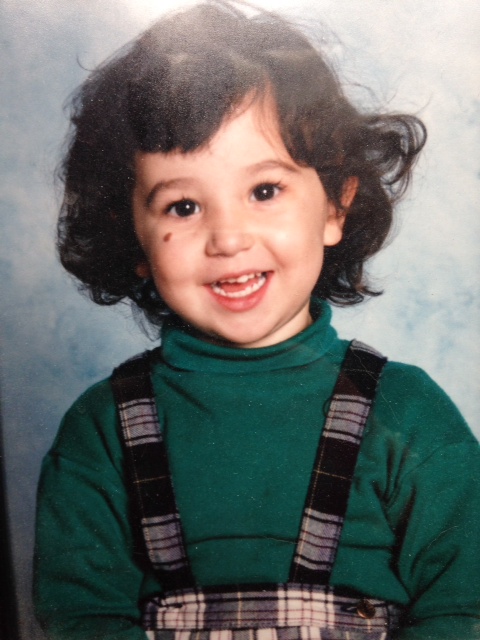Where did you get the idea for The Girl of Ink & Stars?
My parents have an enormous atlas, and growing up my brother and I would put our finger on a place, and then set our games there. We were extremely lucky as we traveled loads. Our parents took us everywhere — Jordan, India, China— and I loved going to new places. India is particularly special to me as my mum is from there, and most of her family still live there. Isabella is based on one of my cousins, Sabine, who lives in New Delhi.
When I was 19, we went on a trip to La Gomera, the second smallest Canary Island. We arrived just after a forest fire, and there were huge swathes of blackened forest and burnt places. I found an overlook with a steep point down to the sea, and I wondered: if I were a girl who didn’t know where I was, how would I feel looking at this sunset?
The Islands are volcanic as well—the settings of all the places in my novel really exist! They have the longest walkable lava tubes where the darkness is so deep, you can be touching your eyelashes and still not see your hand. When I was there, I also read a book of Canary Island myths where I learned about the volcano spirit and his demon dogs. I didn’t write anything until my Creative Writing MSt at Oxford, when it all just came into place.
Why is The Girl of Ink & Stars called The Cartographer’s Daughter in the US and Canada?
Originally, my story was titled The Cartographer’s Daughter, as one of my main inspirations for the book was Philip Pullman’s The Firework-maker’s Daughter. My American publisher, Knopf, decided they liked the adventure and description of this title, whereas my UK publisher, Chicken House, wanted a title that would be beautiful. They also thought it was important that the title was about my protagonist, Isabella, rather than her being someone’s daughter.
I chose The Girl of… format because it has a classic feel to it, and one of my favourite books is called The Girl Who Circumnavigated Fairyland in a Ship of her Own Making by Catherynne M Valente, and I wanted to pay homage to that. Ink and stars are two of the tools of a cartographer.
Who’s your favourite character from The Girl of Ink & Stars?
It’s hard to pick favourites but I loved writing Lupe. She really grows throughout the book, in a way that Isabella doesn’t, because Isabella already knows who she is and what she wants. Lupe starts as a spoilt but loyal girl, and ends up…you’ll have to find out!
What’s your favourite line from The Girl of Ink & Stars?
‘A myth is something that happened so long ago people like to pretend it’s not real, even when it is.’
When and how did you know that you wanted to be a writer?
I have always read and loved children’s books, but the idea of becoming an author didn’t come until I was in my twenties. My partner was a painter and watching him succeed in his passion was inspiring. So instead of going on to study law, I asked myself what I felt passionately about, and the answer was books. I remember what my dad said—it’s easy to fail at what you don’t want to do, so you might as well fail at something you do want to do.
I started by writing and publishing poetry, and I applied to a few creative writing courses. I chose Oxford since the course didn’t make you specialise in poetry, screen writing or children’s books – you do all three before specialising. I began writing GOI&S on the course, and the rest is history!
What is your favourite thing about being a writer?
This sounds obvious, but the writing. When writing is going well, your characters take on a life of their own, and your job is to write down what they are doing, seeing, feeling. It’s a strange and exhilarating experience.
But there are so many brilliant parts to the job: meeting readers, meeting writers you admire, holding finished copies of your book. It can also be frustrating, hard, upsetting – but overall I love it and can’t imagine living any other way.
What are your favourite books and writers?
I read widely and so this list could quickly become ungovernable – will have to be brutal. My favourite authors, as in I would read anything they wrote, include: Philip Pullman, Margaret Atwood, Gabriel Garcia Marquez, Malorie Blackman, Jon McGregor, Bapsi Sidwa, Alison MacLeod, Katherine Rundell, Roald Dahl, Garth Nix, Eva Ibbotson, Diana Wynne Jones, Jeanette Winterson, Joan Aiken…I’ll stop now.
Favourite books include: His Dark Materials by Philip Pullman, the MaddAddam Trilogy by Margaret Atwood, The Girl Who… by Catherine M Valente, One Hundred Years of Solitude by Gabriel Garcia Marquez, The Hearing Trumpet by Leonora Carrington – these are a fraction.
Why do you talk about mental health issues?
I’ve had this question a couple of times now, so thought it was worth addressing on the FAQs. I have had depression and anxiety for several years following a trauma when I was 19, and it’s an important part of my past and occasionally my present. I don’t think it’s anything to be ashamed of, or to hide. For more on how my mental health has affected my writing, please see this piece I wrote for Waterstones.
What’s your favourite colour?
Blue – the blue at the meeting of sky and sea on a clear day.
What would your daemon be?
I wish it were something majestic, like a snow leopard, or intelligent and resourceful, like an otter, but it’s more likely something silly, like a clumsy kitten.
